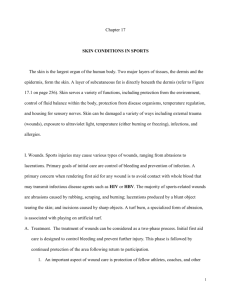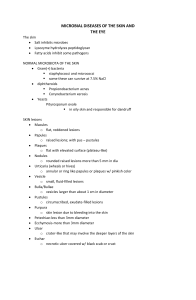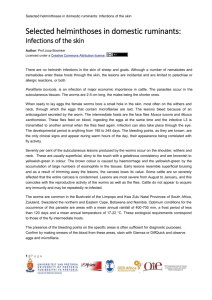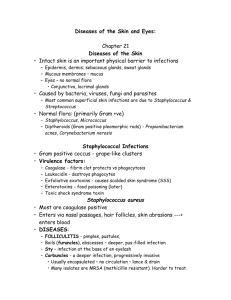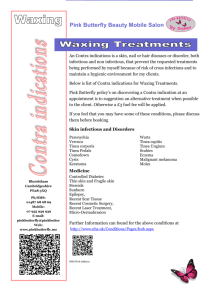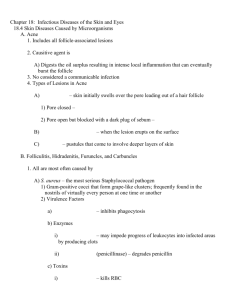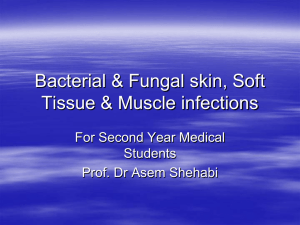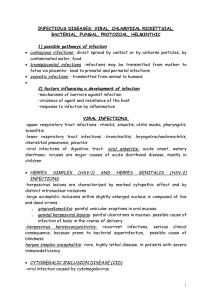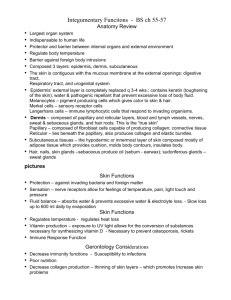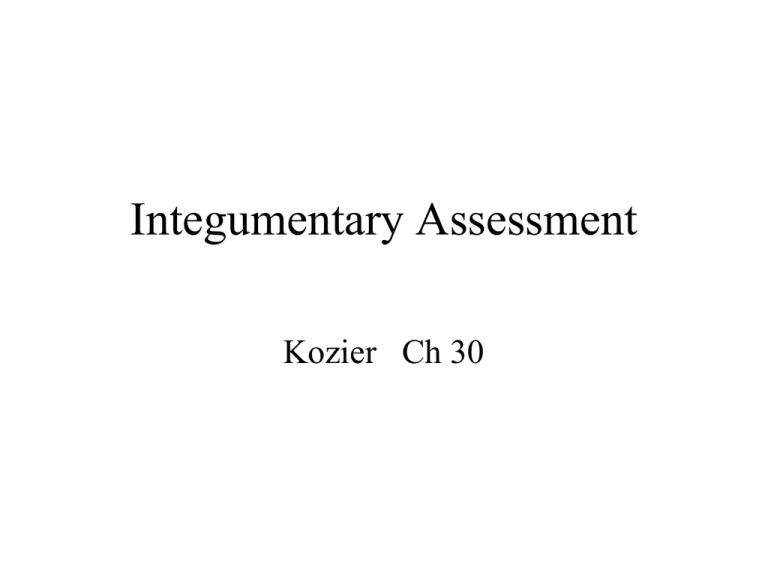
Integumentary Assessment
Kozier Ch 30
What are the Functions of the
Integumentary System?
Functional Review
• Protector and barrier between internal
organs and external environment
• Barrier against foreign body intrusions
– against invading bacteria and foreign matter
• Transmits sensation – nerve receptors
– allows for feelings of temperature, pain, light
touch and pressure
Skin Functions
• Regulates body temperature
– regulates heat loss
• Helps regulate fluid balance
– absorbs water
– prevents excessive water & electrolyte loss.
– Slow loss up to 600 ml daily by evaporation
• Immune Response Function
– inflammatory process
Skin Functions
• Vitamin production
– exposure to UV light allows for the conversion
of substances necessary for synthesizing
vitamin D
– Necessary to prevent osteoporosis, rickets
Skin Assessment
•
•
•
•
•
Visual inspection
Palpation
Olfactory senses
Adequate lighting
Remove necessary clothing while
providing respect and privacy
• Appropriate client positions
p.568
Visual inspection
Skin color:
• Palor
• Cyanosis
• Jaundice
• Erythema
• Hyperpigmentation
• Hypopigmentation – vitiligo
Visible changes if the Skin
• Changes in skin color texture
– Eczema, infections
• Assess the vascularity & hydration of skin
• Edema – swelling, pitting edema
1+ 2 mm
2+ 4 mm
3+ 6 mm
4+ 8 mm
p.579
• Nails – configuration, consistency, color
• Hair – color and distribution, aloplecia,
location
p.579
Gerontology Considerations
Watch for significant changes in aging:
• Decrease immunity functions
• Susceptibility to infections
• Poor nutrition
• Decrease collagen production – loss of
subcutaneous
• Thinning of epidermal skin layers
• Increase skin problems
Gerontology Considerations
•
•
•
•
•
Taking more medications
Excessive environmental exposure
Dryness, wrinkling
Uneven pigmentation
Various proliferative lesions
Assessing light to dark skin
Description
Light skin
Dark skin
Cyanosis - bluish
Bluish tinge
Ashen gray
Pallor - paleness
Loss of rosy glow Ashen gray (drk skin)
Yellowish brown (brown
skin)
Erythema - redness
Visible redness
Diffused; rely on palpation
of warmth or edema
Petechiae – small
size pinpoint
ecchyumosis
Purplish
pinpoints
Usually invisible; check
oral
Mucosa, conjunctiva,
eyelids, conjunctiva
covering eyeballs.
Assessing light to dark skin
Description
Jaundice - yellow
Light skin
Dark skin
Yellow sclera,
Reliable on sclera, hard
skin, fingernails, palate, palms and soles.
soles, palms, oral
mucosa
Ecchymosis – large Purplish to
diffused bluish black yellow-green
Difficult to see, check
mouth or conjunctiva
Brown-Tan – cortisol Bronze;
deficiency, increased Tan to light
melanin production brown
Easily masked.
Assessing Lesions
• Vary in size, shape and cause
• Primary vs. Secondary
• Erruptions: cysts, wheals, bullous, pustules,
psoriasis, eczyma, vesicles, bullae, nodules,
papules
• Discoloration: macules (café-au-lait),
Disorders Affecting the Skin
Skin Lesions
p.755
• Etiology
–
–
–
–
–
–
Infections –herpes, impetigo, HIV, melanoma
Toxic chemicals: skin irritation
Physical trauma: burns, lacerations
Hereditary factors
External factors: allergens, contact dermitis
Systemic diseases: measles, lupus, nutritional
deficiency
Skin Lesions
• Nursing Process Care:
– Assessment: descriptions; pt. history, causative
factors
– Evaluation of skin – identify problem
– Nursing Diagnosis
– Interventions for skin care to promote healing
and prevent further injury
– Pain management & comfort
– Infection control
– Nursing evaluation & reassessment
Systemic Skin Diseases:
Skin Disorders in Diabetes
• Diabetes Dermapathy – shin spots, caused
by break- down of small vessels that supply
the skin.
• Stasis Dermatitis – compromises circulation
to the distal extremities due to damage of
larger vessels.
Problem: Injuries heal slow; increase risk for
ulcerations; risk for skin infections
Fungal infections of the Skin
•
•
•
•
Tinea Pedis (athlete’s foot)
Tinea Corporis (ringworm of the body)
Tinea Capitis (scalp ringworm)
Tinea Cruris (ringworm of the groin)
– Jock itch jock, common in diabetes.
• Tinea Unguium (ringworm of the nails)
– onychomycosis
Parasitic Infections
• Pediculosis capitis - lice
• Pediculosis corporis/pubis
• Sarcoptes scabiei – scabies
– Raised burrows found between fingers, wrists,
elbows, nipples, feet, groin, gluteal folds, penis,
scrotum
– Poor hygienic living conditions
– Increase; contagious
– Secondary lesions: vesicles, papules, crust,
excoriations
Parasitic Infections
– Appear 4 wks after exposure
– Elderly patients from long term facilities
– Lindane, crotamiton (Eurax), permethrin
Nursing Diagnosis
• Skin Impairment r/t:
• GOAL:
– Protect the skin
– Prevent secondary infections
– Promote healing
Skin Care
Review of wound dressings
Wound Dressings
• Occlusive – airtight cover applied to skin
lesions
• Wet –(obsolete) wet compresses applied on
acute weeping, inflamed lesions
• Moisture-retentive –more efficient wet drsg
for removing excudate: impregnated with
saline, petrolatum, zinc-saline, hydrogel,
antimicrobial agents.
– Avoids maceration , less infections,
scarring & reduces pain.
Wound Dressings
• Hydrogels – polymers with 90% water
content
– superficial wounds, abrasions, skin graft
sites, draining venous ulcers
• Hydrocolloids –impermeable to water, O2
– Remain intact during bathing.
– Produce foul-smelling yellowish covering
– May leave on wound for 7 days
– Promote debridment & granulation tissue
Wound Dressings
• Foam – hydrophilic absorption and
hydrophobic backing to prevent leaking of
exudate
– Nonadherent; require secondary dressing
– Used over bony areas and weeping wounds
• Calcium alginates – absorbent fiber packing
made from seaweed.
– Absorbes exudate, best for macerated
wounds, packing deep wounds, sinus
tracking, heavy drainage - nonadherent

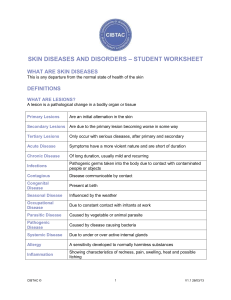
![Occupational Health - Zoonotic Disease Fact Sheets #15 DERMATOMYCOSES Foot)]](http://s2.studylib.net/store/data/013216770_1-db2cdf56a16f26d122fecafe6758caad-300x300.png)
